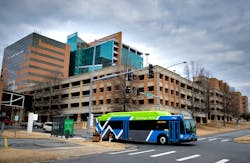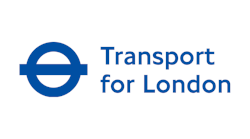o accommodate an ever-changing transit industry, a greater offering for fuel and power sources have made fuel options a complex decision for agencies.
Jean-Yves Vallee, director of product planning, Nova Bus, explained that from the standpoint of the manufacturer, the decision rests on what infrastructure the agency has available. “Usually those decisions are made on the customer side ... because it is a lot of the infrastructure investment on their side ... You need to have the cost of the bus and the infrastructure. The diesel or hybrid are basically stand alone, for CNG and electric, there is an infrastructure element to it.”
The Electric Age
To combat environmental issues facing cities, more agencies are turning to all-electric vehicles. “On the electric side it gets a little more complex,” said Vallee. “You have to look at what kind of electrical requirements that they have and install the charging stations.”
Transport for London (TfL) has been working to reduce bus emissions across its expansive route by an estimated 84 percent. In 2017 the Mayor of London, Sadiq Khan, introduced a plan to roll out more electric buses for TfL.
“London buses are owned by the bus operators, not directly by us. However as we are focused on improving air quality in London we have brought in certain criteria that buses must adhere to,” said Tom Cunnington, head of bus contracts and development at TfL.
Matt Horton, chief commercial officer, Proterra, explained that Proterra has spent many years and a lot of money working to perfect the powertrain. “We now have the battery technology as well as the drivetrain that makes these vehicles the highest performing transit buses ... We’ve got the longest range capability of any vehicle and we also have a drivetrain that accelerates about twice as fast as a diesel bus and is capable of climbing much steeper grades than a traditional internal combustion bus.
“We’ve heard for many years about specific challenges that they [electric buses] raise, and we’ve been working really diligently to knock down those barriers one by one,” said Horton. “The most important thing that people were concerned about was range capability for the vehicles and how could an electric bus truly replace a fossil-fuel bus in transit. I think with the efficiencies of the vehicles and the energy source we have available, combined with charging technology we have available today, we are very confident that we have a bus that can do any route that we need it to do.”
Horton added that the cost of EVs have dropped dramatically. “The cost of batteries have dropped about 75 percent in the last six years. The vehicles are now very cost-competitive, they cost about the same as a diesel hybrid. They cost a little bit more than a diesel or a CNG bus, but because they are so efficient, there is a huge fuel savings and certainly maintenance savings as well.”
Horton said Proterra offers a program for customers to buy its buses without batteries.
“We do recognize that upfront cost and one of the innovations that we have offered ... is a program that we will allow a customer to buy our buses without the batteries and just lease the batteries so that their upfront costs are similar to a fossil fuel-powered bus,” he said.
Charging infrastructure comes into question when going the all-electric route. Cunnington said, “By 2020 it is our aim that all single-decker buses operating in central London will be electric.” Price, charging infrastructure, and range need to be considered in a roll-out like that.
TfL invested around £4.5 million ($6.33 million) in electric charging across London. When it comes to looking into the cost and process of development, agencies have to look at standardizing charging to ensure that they have universal options and charging on a large scale.
“It’s been well proven that it is easy to install and use a small number of chargers for a small number of buses; it’s very straightforward. What is exciting is that now that transit agencies are looking to go 100-percent electric, they want to be sure to work to understand how we can charge several hundred buses in a given location. That is something that we’re spending a lot of time with customers right now.”
Horton added that when it comes to standardization Proterra has adopted plug-in charging standards. “It is the same standard used for the passenger cars out there, so transit doesn’t need to re-invent the wheel. There are good standards already ...”
Turning to CNG
Vallee said when it comes to CNG buses it is no longer such a new idea. The buses have specifications that they need to abide by. Nova Bus manufactures its buses to adapt to the weight of needing to carry the CNG tank on the roof. “What is unique is not the CNG part itself, but the base product on which we’ve built the CNG fueling capabilities on.”
Rock Region METRO switched to CNG, which offered savings for the agency and three compelling features, said Becca Green, director of public engagement at METRO. First, they were able to save money on fuel. In 2016 they saved more than $128,000 under the IRS’s Alternative Fuel Credit. They were able to switch to a cleaner-burning fuel that is better for the environment. Third, they were able to implement this project as a public-private partnership with local municipalities helping to fund the on-site fueling station. Partners were the Arkansas Energy Office, which was a part of the Arkansas Economic Development Commission at the time and is now a part of the Arkansas Department of Environmental Quality, and a local natural gas company.
“All these factors combined made this a win-win situation,” she said. Green explained that there were future benefits to the Little Rock area, as well.
“Although we have not yet had this situation occur, it is possible for our fueling station to be an emergency backup station for the local municipalities that are using natural gas for their support vehicles. By hosting a station of our own, we are contributing to the stability of using compressed natural gas among local government agencies.”
METRO began with 15 CNG buses in service in August 2015. Since then, it placed an additional seven CNG buses in service in October 2017. Green said, “Our goal is to replace our diesel-powered buses with CNG buses by the end of 2025. With 59 buses total, we are at 37 percent completion of that goal.”
Green explained that METRO had a smooth transition into the utilization of CNG. “We did not run into major problems when making the switch from diesel to CNG. There was an almost yearlong period from the construction award to project completion where we made some maintenance facilities modifications and upgrades to accommodate the new fleet, but the work was well-planned, and we used the time to educate our staff on related protocols.”
For Nova Bus, when an agency makes the decision to procure a CNG bus, it typically sees that the funding has already been secured for the infrastructure-side of the project. “What we do in that case ... we will provide them with the standards for the fueling nozzle, and the basic dimensions of the bus to make sure it fits with the infrastructure,” said Vallee.
When Infrastructure Issues Arise
Mountain Line Transit Authority had utilized CNG, but ran into fueling challenges.
Around 2000 , David Bruffy, CEO, CCTM, Mountain Line, said they purchased three extended-body CNG Dodge vans. It was a Department of Energy grant and local service stations, West Virginia University and others put in CNG fueling stations. The vehicles had about a 110-mile range. He said, “We had to fuel them twice a day on the route.”
Mountain Line was then faced with the issue that there was not enough market demand for the CNG pumps. When there were maintenance issues, the pumps were not repaired.
“We ended up with vehicles and nowhere to fuel them. We had to actually tow them out on a flatbed pickup truck. It is a concern that we have now with CNG and that is that either you have to spend a good deal of money to put in your own fueling station or you are going to be depending on a private partner to put in a fueling station and maintain it for you,” said Bruffy. “We’re buying 10 or 12-year buses and their commitment may not be that long, so we could end up in that same kind of situation. Right now in North Central West Virginia there are no CNG fueling stations, so that would be an obstacle for us as well.”
Bruffy added that there is interest in CNG in West Virginia as they are in a Marcellus Shale bed.
“I don’t know that it makes a lot of sense even with that for us to deal with compressed natural gas; all of the issues, the shops, the venting and the maintenance issues.” Bruffy said that he felt EVs would be a more practical route.
“It probably makes more sense for us to go right to electric. The technology in electric is developing very quickly. In addition, we have a solar power plant on top of our building, and we’re doing reverse metering for electric into the local electric grid. That is the probably the area that I am most interested in for an alternative fuel source.”
Mountain Line has operated with both diesel and gas. “We’ve always had diesel within the agency since the very beginning. We have a mix of diesel and gasoline. The diesel engines are typically for the medium- or heavy-duty buses and all of the light-duty buses we’ve always gone with light gas engines,” said Bruffy.






